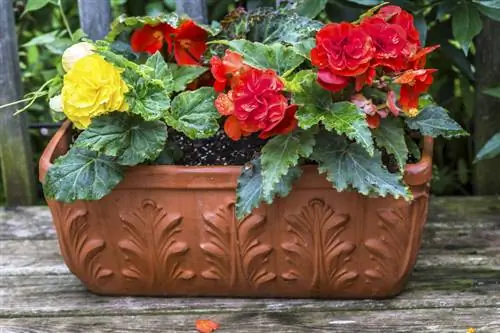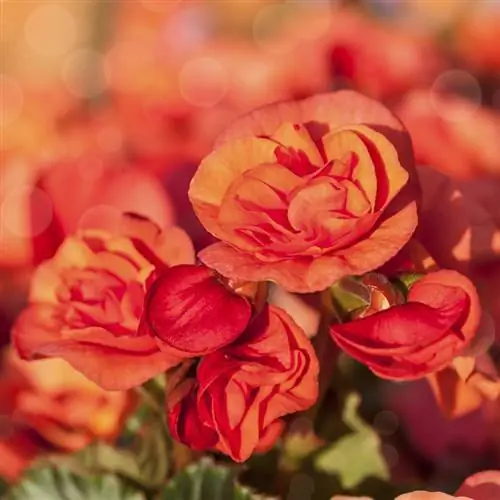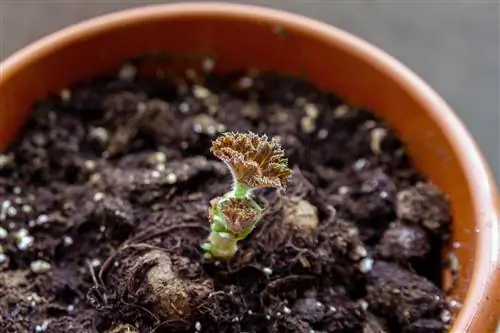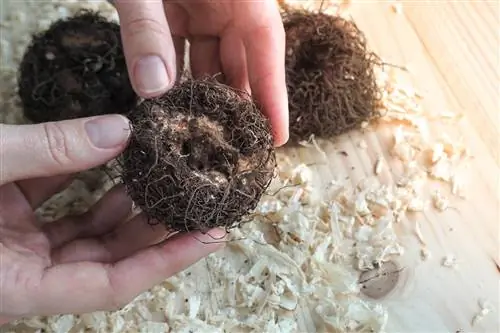- Author admin [email protected].
- Public 2023-12-16 16:46.
- Last modified 2025-06-01 06:02.
Do you want to overwinter tuberous begonias? How to get tuberous begonias safely over the winter. Whether they overwinter better with or without soil - you can find good answers here. The most popular tuberous begonias - Begonia tuberhybrida - and their care during the cold months.
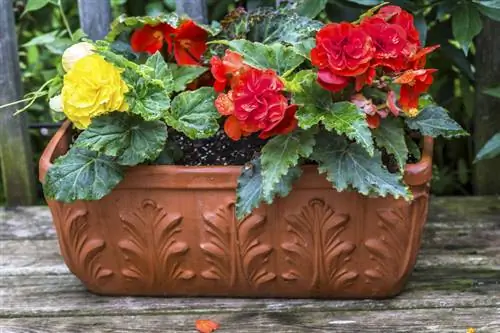
How do I overwinter tuberous begonias successfully?
The best way to overwinter tuberous begonias is to remove them from the ground before the first frost, cut them back to hand height and store them dry in planting substrate, sand or newspaper at around 8°C. Begonias overwintered in pots should only be moistened, not watered.
- Ice begonia - frost-resistant
- Apple Blush - scented
- Multiflora - small-flowered
- Multiflora Maxima - medium floral
- Grandiflora Compacta - large-flowered
- Pendula Champagne - hanging
This is how tuberous begonias can be overwintered with ease
Bugonias come from the tropics of South America. As their name suggests, they form tubers as survival organs. Because they freeze and die at temperatures of 0 degrees, tuberous begonias have to overwinter frost-free. Or you keep buying new ones.
If you want to overwinter tuberous begonias, water more sparingly from the end of September so that the leaves slowly wilt and the plants dry out. This draws the energy reserves from the leaves into the tubers. If tuberous begonias bloom for too long, they lose vigor and grow weaker the following year. Everything else here step by step.
Winter tuberous begonias in the basement to save space
- Remove tubers from the ground before the first frost
- cut back hand high
- check for rot or pest infestation
- remove infected plants or parts of plants
- let it rest in dry plant substrate, sand or newspaper
- store dry and frost-free at around 8° C
Overwinter tuberous begonias in a pot or flower box
If you want to overwinter your tuberous begonias in a pot or flower box, you should note the following. Cut off above-ground parts of the plant to around 2 cm. The most important thing during the winter rest phase: keep tuberous begonias dry! Don't water, just moisten. Otherwise the root tubers will rot. Store the pot or flower box in an airy, dark room at around 8°C. Ventilate regularly in frost-free weather.
Whether with or without a pot - overwintering means a vegetative rest phase for tuberous begonias with a significantly lower need for water and nutrients. If you remove the soil, you still have to make sure that it doesn't dry out! Because they have no protective scale leaves. Therefore, moisten the tubers slightly from time to time. Do not water!
Winter goodbye - prepare the site and plant tuberous begonias
Bugonias grow, depending on the variety, bushy, upright or overhanging and are wonderful, colorful flowers, especially for shady places where otherwise hardly any plants thrive. That's why they're worth saving over the winter.
Like all begonia varieties, they prefer shady to semi-shady places and permeable humus soil. They react sensitively to dryness, blazing sun and waterlogging.
If you prefer overwintered tuberous begonias from February onwards, you will extend the flowering period. To do this, place the tubers in the substrate with the dent facing up and water them. Then place it in a warm, bright place in the house.
When the first leaves sprout you can also fertilize again. Don't put the newly grown tuberous begonias outdoors until after the Ice Saints at the earliest. The first colorful flowers delight our senses from April.
Tips & Tricks
It's worth overwintering tuberous begonias. Mainly because it is simple and takes up little space. In addition, you get larger and more lush begonia plants for your balcony and garden year after year.

